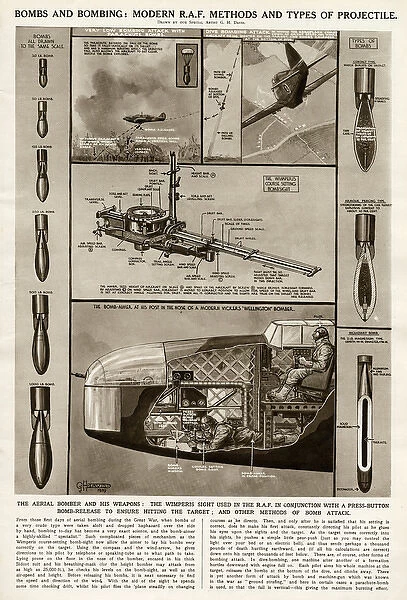Home > Transportation > Aeroplanes
Bombs and bombing, methods and types of projectiles
![]()

Wall Art and Photo Gifts from Mary Evans Picture Library
Bombs and bombing, methods and types of projectiles
The aerial bomber and his waepons: The wimperis sight used in the R.A.F in conjunction with a press-button bomb-release to ensure hitting the target; and other methods of bomb attack. Date: 1939
Mary Evans Picture Library makes available wonderful images created for people to enjoy over the centuries
Media ID 14166142
© Illustrated London News Ltd/Mary Evans
Aircrafts Attack Bomb Bombing Bombs Davis Dive Projectile Projectiles Weapon Wellington Weapons
FEATURES IN THESE COLLECTIONS
> Europe
> United Kingdom
> England
> London
> Sights
> Related Images
EDITORS COMMENTS
This evocative photograph captures the raw power and destructive capability of aerial bombing during the early years of World War II. The image shows an R.A.F (Royal Air Force) pilot in the cockpit of a Wellington bomber, intently focusing on his target through the Wimperis sight. The Wimperis sight, a sophisticated bombing aid, was instrumental in ensuring accurate bombing runs and increasing the effectiveness of air attacks. The Wellington bomber, a key aircraft in the R.A.F's arsenal during the early stages of the war, was equipped with various types of bombs, including high-explosive and incendiary projectiles. The press-button bomb-release, visible in the foreground, allowed the pilot to quickly and efficiently drop his payload. Bombing from the air was a relatively new and devastating military tactic, first employed during World War I. By the 1930s, significant advancements had been made in both the design of bombers and the types of bombs they carried. Dive-bombing, a particularly effective method, involved the pilot deliberately diving towards the target at a steep angle, releasing the bombs just before pulling up to avoid the impact. This photograph, taken in 1939, serves as a stark reminder of the destructive power that the skies held during this period. The image is a testament to the technological advancements of the time and the strategic importance of air power in modern warfare.
MADE IN THE UK
Safe Shipping with 30 Day Money Back Guarantee
FREE PERSONALISATION*
We are proud to offer a range of customisation features including Personalised Captions, Color Filters and Picture Zoom Tools
SECURE PAYMENTS
We happily accept a wide range of payment options so you can pay for the things you need in the way that is most convenient for you
* Options may vary by product and licensing agreement. Zoomed Pictures can be adjusted in the Basket.



